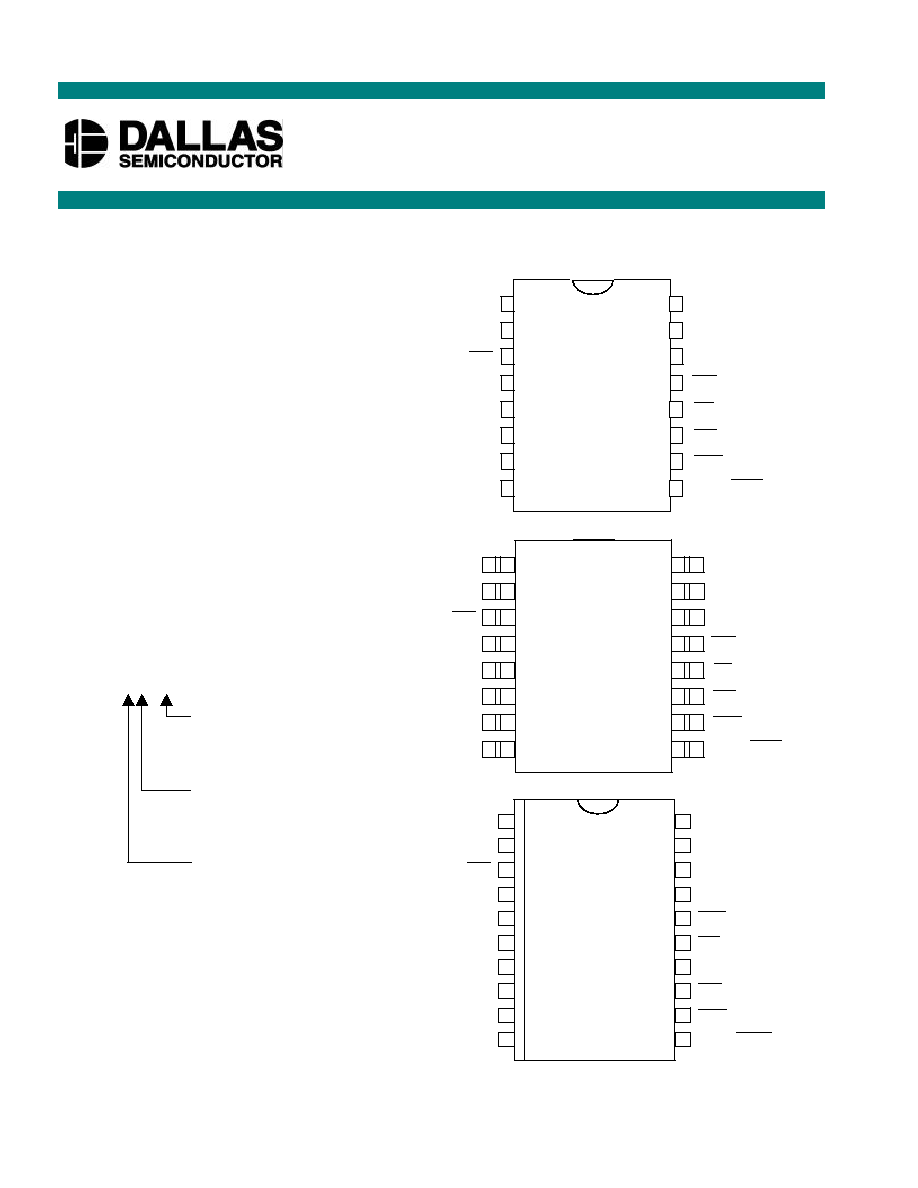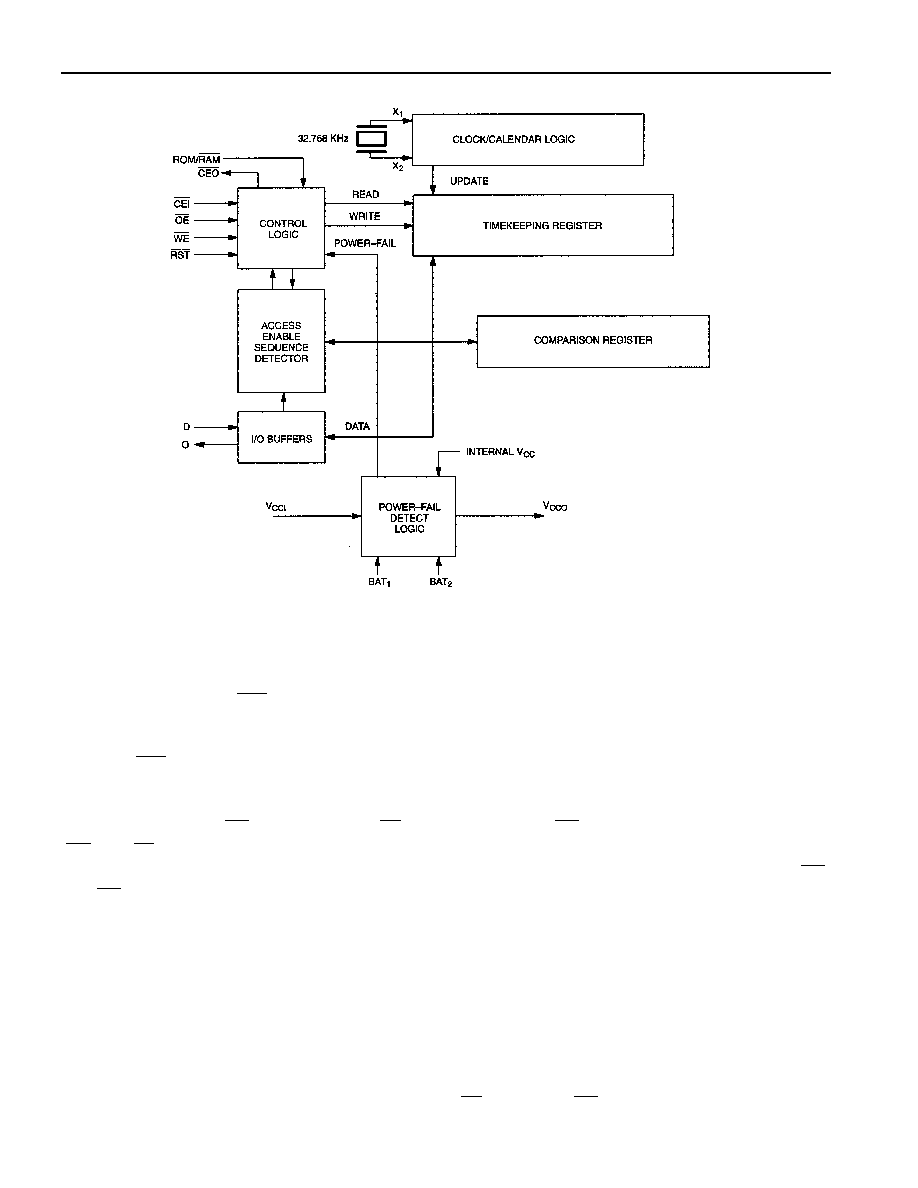
1 of 21
082699
FEATURES
ß
Real time clock keeps track of hundredths of
seconds, seconds, minutes, hours, days, date
of the month, months, and years
ß
Adjusts for months with fewer than 31 days
ß
Automatic leap year correction valid up to
2100
ß
No address space required to communicate
with RTC
ß
Provides nonvolatile controller functions for
battery backup of SRAM
ß
Supports redundant battery attachment for
high≠reliability applications
ß
Full ±10% V
CC
operating range
ß
+3.3 volt or +5 volt operation
ß
Industrial (≠45∞C to +85∞C) operating
temperature ranges available
ß
Drop in replacement for DS1215
ORDERING INFORMATION
DS1315XX-XX
33-3.3 volt operation
5-5 volt operation
blank-commercial temp range
N-industrial temp range
blank-16-pin DIP
S-16-pin SOIC
E-20-pin TSSOP
PIN ASSIGNMENT
DS1315
Phantom Time Chip
www.dalsemi.com
{
16-Pin DIP (300-mil)
1
2
3
4
5
6
7
8
16
15
14
13
12
11
10
9
V
CC1
V
CC0
BAT2
RST
OE
CEI
CEO
ROM/RAM
X1
X2
WE
BAT1
GND
D
Q
GND
20-Pin TSSOP
X1
X2
WE
NC
BAT1
GND
NC
D
Q
GND
9
1
2
3
4
5
6
7
8
10
20
19
18
17
16
15
14
13
12
11
V
CC1
V
CC0
BAT2
NC
RST
OE
NC
CEI
CEO
ROM/RAM
16-Pin SOIC (300-mil)
1
2
3
4
5
6
7
8
16
15
14
13
12
11
10
9
V
CC1
V
CC0
BAT2
RST
OE
CEI
CEO
ROM/RAM
X1
X2
WE
BAT1
GND
D
Q
GND

DS1315
2 of 21
PIN DESCRIPTION
X1, X2
- 32.768 kHz Crystal Connection
WE
- Write Enable
BAT1
- Battery 1 Input
GND
- Ground
D
- Data Input
Q
- Data Output
ROM/
RAM
- ROM/RAM Mode Select
CEO
- Chip Enable Output
CEI
- Chip Enable Input
OE
- Output Enable
RST
- Reset
BAT2
- Battery 2 Input
V
CC0
- Switched Supply Output
V
CC1
- Power Supply Input
DESCRIPTION
The DS1315 Phantom Time Chip is a combination of a CMOS timekeeper and a nonvolatile memory
controller. In the absence of power, an external battery maintains the timekeeping operation and provides
power for a CMOS static RAM. The watch keeps track of hundredths of seconds, seconds, minutes,
hours, day, date, month, and year information. The last day of the month is automatically adjusted for
months with less than 31 days, including leap year correction. The watch operates in one of two formats:
a 12-hour mode with an AM/PM indicator or a 24-hour mode. The nonvolatile controller supplies all the
necessary support circuitry to convert a CMOS RAM to a nonvolatile memory. The DS1315 can be
interfaced with either RAM or ROM without leaving gaps in memory.
OPERATION
The block diagram of Figure 1 illustrates the main elements of the Time Chip. The following paragraphs
describe the signals and functions.

DS1315
3 of 21
TIMING BLOCK DIAGRAM Figure 1
Communication with the Time Chip is established by pattern recognition of a serial bit stream of 64 bits
which must be matched by executing 64 consecutive write cycles containing the proper data on data in
(D). All accesses which occur prior to recognition of the 64-bit pattern are directed to memory via the
chip enable output pin (
CEO
).
After recognition is established, the next 64 read or write cycles either extract or update data in the Time
Chip and
CEO
remains high during this time, disabling the connected memory.
Data transfer to and from the timekeeping function is accomplished with a serial bit stream under control
of chip enable input (
CEI
), output enable (
OE
), and write enable (
WE
). Initially, a read cycle using the
CEI
and
OE
control of the Time Chip starts the pattern recognition sequence by moving pointer to the
first bit of the 64-bit comparison register. Next, 64 consecutive write cycles are executed using the
CEI
and
WE
control of the Time Chip. These 64 write cycles are used only to gain access to the Time Chip.
When the first write cycle is executed, it is compared to bit 1 of the 64-bit comparison register. If a match
is found, the pointer increments to the next location of the comparison register and awaits the next write
cycle. If a match is not found, the pointer does not advance and all subsequent write cycles are ignored. If
a read cycle occurs at any time during pattern recognition, the present sequence is aborted and the
comparison register pointer is reset. Pattern recognition continues for a total of 64 write cycles as
described above until all the bits in the comparison register have been matched. (This bit pattern is shown
in Figure 2). With a correct match for 64 bits, the Time Chip is enabled and data transfer to or from the
timekeeping registers may proceed. The next 64 cycles will cause the Time Chip to either receive data on
D, or transmit data on Q, depending on the level of
OE
pin or the
WE
pin. Cycles to other locations

DS1315
4 of 21
outside the memory block can be interleaved with
CEI
cycles without interrupting the pattern recognition
sequence or data transfer sequence to the Time Chip.
A standard 32.768 kHz quartz crystal can be directly connected to the DS1315 via pins 1 and 2 (X1, X2).
The crystal selected for use should have a specified load capacitance (C
L
) of 6 pF. For more information
on crystal selection and crystal layout considerations, please consult Application Note 58, "Crystal
Considerations with Dallas Real Time Clocks."
TIME CHIP COMPARISON REGISTER DEFINITION Figure 2
NOTE:
The pattern recognition in Hex is C5, 3A, A3, 5C, C5, 3A, A3, 5C. The odds of this pattern being
accidentally duplicated and causing inadvertent entry to the Phantom Time Chip are less than 1 in 10
19
.

DS1315
5 of 21
NONVOLATILE CONTROLLER OPERATION
The operation of the nonvolatile controller circuits within the Time Chip is determined by the level of the
ROM/
RAM
select pin. When ROM/
RAM
is connected to ground, the controller is set in the RAM mode
and performs the circuit functions required to make CMOS RAM and the timekeeping function
nonvolatile. A switch is provided to direct power from the battery inputs or V
CCI
to V
CCO
with a
maximum voltage drop of 0.3 volts. The V
CCO
output pin is used to supply uninterrupted power to CMOS
SRAM. The DS1315 also performs redundant battery control for high reliability. On power-fail, the
battery with the highest voltage is automatically switched to V
CCO
. If only one battery is used in the
system, the unused battery input should be connected to ground.
The DS1315 safeguards the Time Chip and RAM data by power-fail detection and write protection.
Power-fail detection occurs when V
CCI
falls below V
PF
which is set by an internal bandgap reference. The
DS1315 constantly monitors the V
CCI
supply pin. When V
CCI
is less than V
PF
, power-fail circuitry forces
the chip enable output (
CEO
) to V
CCI
or V
BAT
-0.2 volts for external RAM write protection. During
nominal supply conditions,
CEO
will track
CEI
with a propagation delay. Internally, the DS1315 aborts
any data transfer in progress without changing any of the Time Chip registers and prevents future access
until V
CCI
exceeds V
PF
. A typical RAM/Time Chip interface is illustrated in Figure 3.
When the ROM/
RAM
pin is connected to V
CCO
, the controller is set in the ROM mode. Since ROM is a
read-only device that retains data in the absence of power, battery backup and write protection is not
required. As a result, the chip enable logic will force
CEO
low when power fails. However, the Time
Chip does retain the same internal nonvolatility and write protection as described in the RAM mode. A
typical ROM/Time Chip interface is illustrated in Figure 4.
DS1315 TO RAM/TIME CHIP INTERFACE Figure 3




